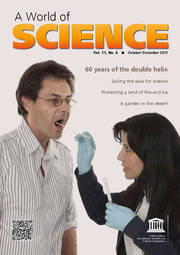Vol 2 N° 3 [July–September 2004]
CONTENTS
IN FOCUS
p 2 - A system for managing the planet by 2015
NEWS
p 8 Health and food security focus top women researchers
p 8 Mountain climate change study gains ally in GLOCHAMORE
p 9 Stemming brain drain with the Grid in Southeast Europe
p 10 New Chair takes science from the university to the village
p 10 Israeli-Palestinian Science Organization born
INTERVIEW
p 10 - Osman Benchikh on why the age of renewables has now begun
HORIZONS
p 13 - Saving a survival kit for the poor
p 16 -A tale of five cities
IN BRIEF
p 20 - Diary
p 20 - New releases
p 20 - Governing bodies
Quick link to Vol. 2 n° 3 (PDF document);
See also ARCHIVES for A World of Science
EDITORIAL
The new space race
For years, climate researchers have struggled with the fact that temperatures in the first 11 km of the atmosphere (the troposphere) have been rising far slower than models predict, given the speed at which the Earth’s surface is heating. This apparent discrepancy has fuelled sceptics’ arguments about global warming.
A new study published in the 6 May edition of Nature could silence the sceptics. According to this study, it is stratospheric cooling (above 11 km), a known effect of greenhouse gases, which accounts for the discrepancy. These findings result from statistical analyses of data collected from polar-orbiting satellites of the US National Oceanic and Atmospheric Administration.
Sceptics may scoff but the great majority of experts today concur that the climate is changing at an unprecedented rate and that this change is largely driven by human activities. We need to apply the Precautionary Principle and take immediate remedial action, since the longer it takes us to agree on a diagnosis of the planet’s ills and the means of remedying these, the worse our environmental – and socio-economic – problems will become. In some cases, the damage will be irreparable. Biodiversity is shrinking daily, the victim of forest fires, land-clearing, pollution and other threats. According to Brazil’s National Space Sciences Institute, 23,750 km2 of Amazonian rainforest were cut down in the twelve months to August 2003. Of all the plant species we can’t even put a name to yet, half of which are thought to grow in the Amazon, we can reasonably assume that some disappeared forever with that section of forest and with them the molecules for curing a whole range of existing and emerging human diseases.
Biodiversity loss, climate change and forest destruction are all interwoven problems. Since land, water and atmosphere are interlocking components of a single Earth system, our global Earth observing initiatives likewise need to be interlocking. Scientists are already working together on urgent questions for our future survival, such as how to increase agricultural productivity, attenuate the impact of earthquakes, or protect our children from atmospheric pollution. But for Earth observation to be comprehensive, sustained and perfectly co-ordinated, it needs political backing.
Now, it would seem, we have that political backing. In this issue, we look at a governmental initiative to put in place a Global Earth Observation System of Systems by 2015. Unlike the ‘space race’ before it, this new space race is fuelled not by Cold War politics but by a far more critical goal: the quest to understand the planet’s life-support systems in order to protect them – and us.
W. Erdelen
Assistant Director-General for Natural Sciences

